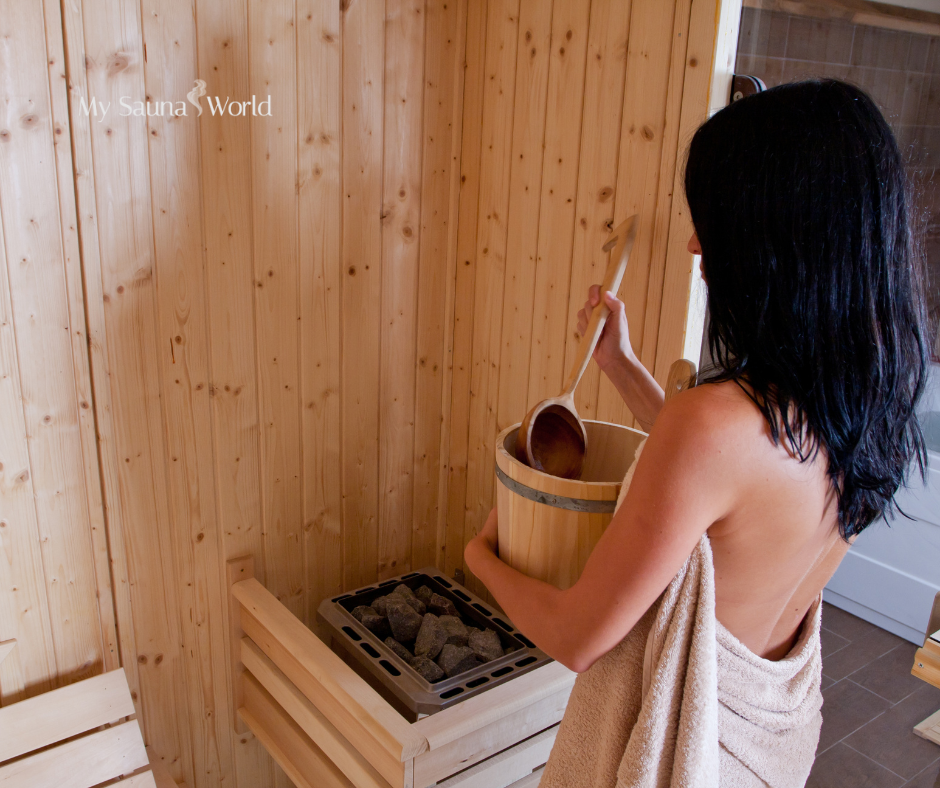7 WAYS TO MAXIMIZE THE HEALTH BENEFITS OF A WET SAUNA
Saunas are increasingly becoming popular home additions due to the numerous health benefits and increasing home value. So, if you’re looking to add a sauna to your home, there are several factors to understand, especially when it comes to the terminology.
A traditional sauna can be both a “dry sauna” and a “wet sauna,” it all depends on how you use it. Using a traditional sauna as a dry sauna and as a wet sauna provides different benefits, so understanding how these differences may impact how you choose to utilize your own sauna. This article will be looking at the best ways to maximize the health benefits of a wet sauna, in particular.
Difference Between a Dry and Wet Sauna

Most modern saunas use a heater and sauna rocks heated to a high temperature. As mentioned in the introduction, a sauna using a wood-burning stove or a more modern electric stove can be used as a dry or wet sauna. The main difference is the humidity and temperature in the sauna. You splash water on the sauna rocks with a wet sauna to create steam, which is why a wet sauna is often known as a steam sauna.
Since the rocks are heated to extreme temperatures, the water vaporizes fast, causing steam formation. When utilizing a sauna as a dry sauna, there are just heated rocks and no water used. When you use a wet sauna, you sweat more, releasing unwanted toxins from the body. Regular use of a wet sauna reduces the chances of certain illnesses because bacteria and viruses cannot survive in such high temperatures.
On the other hand, dry saunas relieve stress and tension, help rejuvenate the skin via perspiration, and stimulate blood circulation. Like with a wet sauna, using a dry sauna causes you to sweat, invoking similar benefits to a wet sauna. Dry saunas use dry heat from an electric or wood-fired sauna heater or infrared rays in infrared saunas.
How you choose to utilizie your sauna depends on your preference since both the dry sauna experience and the wet sauna experience provide similiar benefits. Again, it’s important to note that a dry and wet sauna can be the same. A dry sauna becomes a wet sauna when you pour water on the hot sauna rocks.
7 Ways to Maximize the Benefits of a Wet Sauna

Adding Aromatherapy Essential Oils
Using a sauna is beneficial and enjoyable, but you can make the experience even better with essential oils. Using aromatherapy in your wet sauna requires knowing how to use and understand the best essential oils. Before using the essential oils, they must be diluted in water to reduce the intensity exposure because the essential oils have strong scents and are safer, minimizing the risk of flammability. The most common method is adding a few drops of essential oil to the water bucket in your sauna. When you pour this water over the hot sauna stones, the steam generated will have a pleasant scent. Sauna and aromatherapy are a great combination that relaxes the body and improves well-being. You can use several essential oils for your sauna, with each scent providing unique benefits. Our recommended essential oils to use include:
-
Eucalyptus: Good for boosting energy, relieving stress, and fighting against colds
-
Lavender: The aroma helps users calm down during stress
-
Pine: It’s energizing oil that promotes awareness and focus, reduces inflammation, fights bacteria, and improves mood.
-
Peppermint: It has energizing and cooling properties and relieves pain. Headaches, inflammation, and relieves shoulder and back pain
-
Lemon: Lemon is a natural detoxifier containing antiseptic properties. It also removes pore-clogging oils, tightens the skin, and prevents wrinkles.
-
Ylang Ylang: Good for boosting mood, reducing stress, depression symptoms, and feelings of sadness
-
Cedarwood: Helps calm anxiety and stress and improves skin. It also helps with skin inflammation and irritation and is a natural detoxifier.
-
Frankincense: Encourages respiratory health by clearing the airways. It also helps with colds and flu, and allergies and strengthens immunity.
-
Tea Tree: Prevents the growth of certain types of bacteria growth and is used as an antiseptic
Other recommended essential oils include:
-
Birch
-
Cinnamon
-
Citrus
-
Sandwood
-
Grapefruit
-
Lemongrass
-
Bergamot
-
Geranium
The choice of essential oils for your steam sauna depends on your preferences. You can even combine different oils – such as a combination of pine, spruce, and cedar. The mixture creates a natural and fresh aroma inspired by the smells and feeling of untouched Nordic nature.
Get your Blood Flowing Before a Sauna Session
You should get your blood flowing before starting a sauna session. You can dilate your blood vessels before the session to increase blood flow. Doing this will help relax your tense muscles more easily and relieve tired joints. These advantages are ideal for people suffering from arthritis or other types of chronic pain. Some of the activities you can do to get your blood flowing before a wet sauna session include:
-
Yoga or Qi Gong
-
A quick gym session
-
Stair runs or jumping jacks
-
Jog around the block
Rinse Yourself and Your Feet before Getting in the Sauna
Rinsing yourself and your feet before your sauna session is good for hygiene and makes people sweat more heavily and rapidly. This gives sauna bathers an extra refreshing and restorative experience. Showering before the session also stimulates the blood flow through the body while removing lotions, dirt, and other residues clogging the pores. This allows you to sweat freely. After rinsing, it’s important to dry yourself thoroughly to ensure the moisture on the skin doesn’t slow down the sweating process. Besides, a nice shower ensures that you start your session without any chemicals on the skin and saves you time cleaning afterward by cutting back on grime and sweat left behind.
Meditating While Using the Sauna
If you’re a fan of meditation or have thought of giving it a try, you can add this unique twist and meditate in your wet sauna. Meditation and sauna bathing are ideal for any wellness routine and can help save time while doubling down on relaxation.
Your sauna is the best meditation spot as the warm temperature, and serene environment make it the best place to relax your muscles and includes breathing exercises. This helps strengthen your respiratory system and calm your central nervous system.

SIGN UP. SAVE BIG.
Subscribe to be the first to know about our special monthly sauna sales, sent right to your inbox.
For the best results, ensure you’re seated with your back against the wall. This reduces the risk of injury and makes for the most comfortable position.
There are several different meditating methods that you can do in a sauna. Some of the best meditation types for the sauna include:
Transcendental meditation: Repeating a silent mantra in your head for around 15-20 minutes with your eyes closed.
Mindfulness meditation: Allows people to become aware of their body, mind, and general consciousness.
Focused meditation: This involves focusing your attention on different senses like tastes, breathing, smells, sounds, sights, and other sensations.
Progressive relaxation: Releasing tension in the body by clenching a muscle group at a time and releasing, slowly moving through, everyone.
Movement meditation: Walking or controlled exercises. You can stretch or move into different yoga poses.
Below is how you can meditate in your sauna:
-
Ideally, choose a time when it’s quiet (this is a benefit of having a home sauna rather than going to the gym or other public place)
-
Include sound, like a soundtrack of running water, bells or other nature sounds
-
Add aromatherapy
-
Set a timer
-
Be sure to hydrate before and after
Since we’re all different, you can experiment with different meditation methods. Some sauna users find their meditation enhanced by scents, while others feel it by lighting or music. You must pay attention to your mind and body and leverage your time in your sauna to reach even deeper relaxation and cleansing levels.
The Nordic Cycle
The Nordic cycle begins with a 20-minute hot sauna session, alternated by a cold water immersion session. It’s alternating between hot saunas and icy cold water, a routine that has been used in Nordic cultures for centuries. The technique may feel intense for first-time practitioners, but the benefits are worth it. Heat exposure causes the dilation of blood vessels, which increases circulation throughout the body. Conversely, the cold session constricts the blood vessels, increasing the pressure in the circulatory system. Nordic cycle therapy is ideal for competitive athletes looking for the fastest recovery method. It also enhances post-exercise recovery, making it an ideal option for people looking for the best output. The benefits of Nordic cycle therapy include the following:
-
Enhanced healing process
-
Reduced swelling
-
Reduced risks of scar tissue
-
Reduced mood and pain elevation
-
Reduces the risks of Alzheimer’s disease and dementia
-
Reduces or stops the effects of chronic inflammation
-
Detoxifier and boosting immunity
-
Recovery from muscle soreness
-
Helps rejuvenate the skin
-
Improve d blood circulation
While the practice is safe for more people, it can be risky for people with pre-existing health issues. The practice produces fast changes in the circulatory system, so you must always start with the heat before the cold session to prevent adverse impacts.
Stay in the Sauna Until You Feel Tired
Saunas can be just as strenuous as a workout. According to experts, a Nordic practice raises the heart rate and blood pressure like a stint on a rowing machine. Therefore, the dry heat of a sauna places physical strain on the body. This is why you’re given a time limit in a single sauna session. Health experts recommend around 20-30 minutes. To repeat the maximum benefits of your sauna session, you should stay there until you feel tired. This shows that your body has reached the optimum levels.
Use Your Sauna Regularly and Using the Steam Function

Using a sauna regularly exposes your body to persistent heat, which has many health benefits. Saunas have been proven to improve overall health, wellness, and performance. The more you use your sauna, the more likely you will realize these benefits. Studies have shown that the most benefit is found when you use your sauna 3-7 times per week. Moreover, the steam function in your sauna helps open your pores and cleanse your skin.
The steam helps loosen debris and dirt buildup, improving your skin’s appearance. The steam also moisturizes, opens the lungs, and hydrates your respiratory tract. If you struggle with congestion, the steam acts as a humidifier, clearing your nasal passage for easier breathing.
Summary of the Health Benefits of a Wet Sauna
There are several ways to maximize the health benefits of a wet sauna. For the best results, add aromatherapy essential oils to the water bucket before you ladle the water onto the hot rocks, get your blood flowing before the session, and try meditating while using the sauna.. Moreover, you can use the Nordic cycle, stay in the sauna until you feel tired, and use your sauna regularly while utilizing the steam function. For more information on how to get the best out of your wet sauna, continue following and trusting our experts at GRIM PARENT LIMITED.